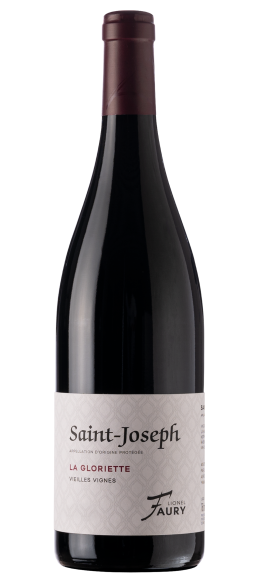
La Gloriette, Saint Joseph, Domaine Faury
- Region
- Saint Joseph, Rhone, France
- Vintage:
- 2022
- Producer:
- Domaine Faury
- Grapes:
- Syrah/Shiraz
Wine Description:
The nose opens with small black fruits, enhanced by noble notes of graphite and toasted bread crust. The palate is ample and complex and reveals an aromatic blend of black fruits, spices and braised/peppery notes; supported by a firm and velvety tannic structure.
100% Syrah (mass selections from Serine)
Soil: Velay granites. Selection of the oldest vines on the estate (50 to 80 years old) facing North East, North West, at the place called “Le Blanchard”
Vinification / Aging / Blending: harvested in 50 kg crates, the grapes are vatted with a proportion of 45 to 75% whole grapes. The vatting lasts about 3 weeks, alternating pumping over and gentle manual punching down. The wines are then racked into demi-muids (600 liters) for a period of 15 to 18 months. The blending is carried out in bulk one month before bottling, which is carried out by gravity and without filtration.
Food pairings: small autumn game in sauce (pigeon, wild duck, etc.), roast game (leg of venison, roasted wild boar shoulder, etc.)
Producer Description
It was mainly the Romans who were responsible for the development of steep vineyards in this part of the Rhone Valley. Well aware that the steep hillsides that wind along the Rhone were best suited to producing wines with a pronounced character, it is a real agricultural and architectural heritage that persists today.
But having the chance and the opportunity to work these hillsides today does not allow us to escape the difficulty and the demands of the work that these steep terroirs entail.
The gestures of the men who work the land then take on their full meaning, as soon as we understand that there is singular attention paid to each vine.
Leaving the banks of the Rhone River in 1950, Jean Faury settled in the hamlet of La Ribaudy, on the heights of the village of Chavanay. He cultivated fruit trees and vines and also had a few animals. The fruit was sold in the markets of the surrounding villages and sometimes further afield. The wines were delivered in bulk to the bistros in the area but especially around St-Etienne, intended for the coal miners.
The estate is located in the northern part of the Rhone Valley, approximately 50 km from the towns of St-Etienne, Lyon and Valence.
Geologically located on the foothills of the Massif Central, it is however mainly the Alps that can be seen to the east, with the Vercors, Chartreuse and Belledonne ranges.
The Pilat massif where we are located and the regional natural park that is attached to it, presents multiple facets of agriculture: market gardening and arboriculture on the banks of the Rhône, viticulture on the first slopes of Pilat, Pilat apples on the first plateau and finally goat breeding (AOP Rigotte de Condrieu), pigs and cattle at altitude. Products that you will find both at the producers and on the menus of the surrounding restaurants.
